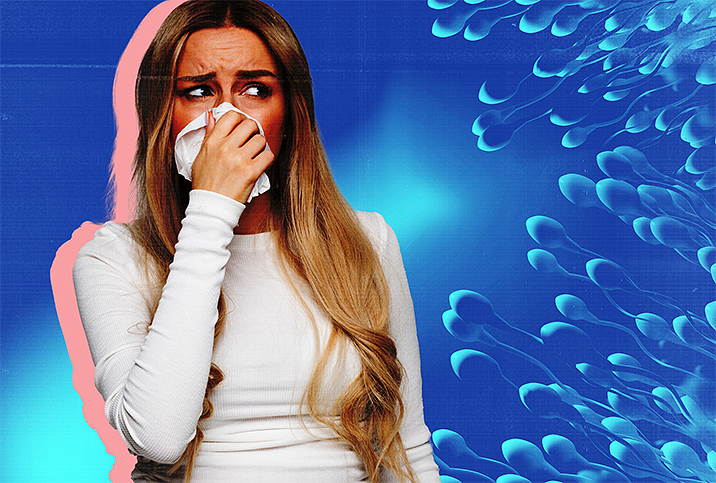Allergies: A Modern Problem With Modern Solutions

In 2015, Emily Allen went to a Cheesecake Factory with her friend and ordered a chicken Caesar salad. After about five bites, she asked, "What's going on? I feel like I've swallowed a bunch of rocks."
Allen, who works as a registered nurse at UNC Health, affiliated with the University of North Carolina at Chapel Hill, has a variety of food allergies, including a life-threatening peanut allergy. When she realized she had eaten something she shouldn't have, she took an antihistamine and quickly drove to a nearby store to get some ipecac syrup to make herself vomit.
As she walked inside the store, she felt her airway begin to swell. Pulling out her EpiPen, an injectable device that delivers the drug epinephrine, she asked a store employee to call 911. Allen told herself she'd give herself a shot if she felt any worse. The paramedics arrived and immediately administered epinephrine and steroids, and hauled her to the emergency room.
Fortunately, Allen survived and hasn't had a severe allergic reaction since.
"Having a life of allergies means living a life of constant vigilance," Allen explained. "I can never, ever, ever let my guard down. I have to be careful with every single thing I put in my mouth."
In addition to food allergies, Allen has environmental allergies—trees, grasses and molds—and allergies to cats, dogs, horses and cockroaches.
"Sometimes I feel like the shorter list is the things I'm not allergic to," she said.
'Having a life of allergies means living a life of constant vigilance. I can never, ever, ever let my guard down.'
While Allen is a particularly severe case, more than 50 million Americans suffer from various types of allergies, according to the American College of Allergy, Asthma & Immunology. But it wasn't always this way. Experts say allergies are largely a modern phenomenon and they've only gotten worse in recent years.
"As with many conditions, there's a spectrum in terms of severity," said Joshua Davidson, M.D., an allergist and immunologist in Redondo Beach, California. "Those who have more mild symptoms—whether it be a food allergy, allergic rhinitis, hay fever or eczema—they handle it day to day and they're fine, perhaps with minimal intervention. Those on the severe side, I would say it's highly impactful."
Davidson added the current data supports an increase in the incidence of allergies across the board, whether they involve food or environmental elements.
Causes behind the increase
Hay fever, or allergic rhinitis, was first reported in 1819. These are seasonal allergies that affect many people, causing itchy eyes and cold-like symptoms such as runny nose, sneezing and sore throat.
By the early 20th century in the United States, the number of allergies had increased 15 percent in roughly 100 years, according to Harold Nelson, M.D., an allergist and immunologist at National Jewish Health in Denver. This increase corresponded to the period following the Industrial Revolution, the shift from a predominantly farming population to an urban one.
"It's been well shown that children who are raised on farms and have contact with farm animals are much less likely to have any of the allergic diseases," Nelson explained.
The bacteria associated with farm animals and hay are protective against allergy. When people get into a more hygienic environment, not only away from farm animals but one with clean water, allergies tend to increase. This common theory is called the "hygiene hypothesis," the notion that developed countries have essentially become too clean, leading to decreased exposure to noninfectious microorganisms.
Other factors that could be contributing to the increase in allergies are the overuse of antibiotics, hand sanitizers and antibacterial wipes, Davidson noted. Nowadays, people, especially children, are not exposed to dirt and grass as much as past generations. Routine contact with certain forms of bacteria helps train our immune systems to distinguish between what is foreign and what can be tolerated.
"When you lose that ability to tell foreign from self-[antigens], the body's immune system becomes imbalanced and can identify common things like dust mites and pollen and animal dander as harmful when it really isn't," he added.
Risk factors for asthma and allergies
The second major increase in allergies, as well as an increased prevalence of asthma in the Western world, happened around 1980. Scientists initially struggled to find an explanation—the hygiene hypothesis failed because hygiene improvements had occurred much earlier. According to Nelson, the sudden spike in asthma and allergies at this point attracted much attention and is more of a mystery than the rise that occurred during the 19th and early 20th centuries.
However, Nelson continued, doctors do know a number of associated risk factors for allergies and asthma, and some or all of them likely contributed to the increase that has occurred over the past 40 years. One factor is air pollution, particularly diesel exhaust fumes, which have been clearly shown to be capable of increasing allergy sensitization.
Another strong factor is the change in our dietary habits. Take the Mediterranean diet, for example, which consists of seafood, olive oil, fresh vegetables and fruits, and limited red meat. It is known to be protective against allergies. However, the more recent decline in the ingestion of fresh fruits and vegetables has been associated with the increased prevalence of allergies, Nelson explained. In fact, the International Study of Asthma and Allergies in Childhood (ISAAC) found eating fast food three or more times per week was associated with an increased risk of severe asthma, rhinoconjunctivitis and eczema among children.
Pollution due to outgassing—the release of trapped gas or vapor that was previously dissolved, trapped, frozen or absorbed in a solid—from plastics, bottles and canned goods, pesticides, and chemicals found in plastics and cosmetics has also been associated with increased risk of asthma, Nelson added.
The U.S. government periodically conducts a survey to determine the prevalence of allergic diseases, as well as skin tests with a battery of routine allergens. These allergy skin-prick tests involve placing small amounts of substances on the skin, then pricking the skin so the allergen gets under the skin's surface.
"Over a period of about 15 years in the 1980s and 1990s, the prevalence of positive pricked-skin tests in the U.S. population doubled," Nelson said.
Allen, who was born in the 1980s and had this test done as a child, said, "I lit up like a Christmas tree."
Improvements in treatment
Modern treatments for allergies are several cuts above those of years past. Antihistamines were developed in the 1940s during World War II. Early medicines, including the brand Benadryl, were very sedative, but now there are many nonsedating antihistamines, such as Zyrtec and Claritin.
"They don't cure the disease, they have no lasting effect and they don't even relieve all the symptoms in most people," Nelson said. "But they certainly are better than nothing."
Nasal sprays, such as the brand Flonase, are typically more effective. However, the only treatments that really affect the underlying allergic condition are allergy shots and, less commonly, sublingual allergy tablets for some allergies.
"In general, the effect of allergy shots is greater than that of either pills or nasal sprays," Nelson explained. "It sort of normalizes the underlying immune system, so after you quit a course of treatment, there's a persisting benefit that can last for a number of years."
'It's not like staph infection or strep throat, where it's cured. In this case, it's controlling a chronic condition.'
Davidson believes treatments today do a very good job controlling symptoms for most patients.
"That's the key with allergies, because we're not curing them," he noted. "It's not like staph infection or strep throat, where it's cured. In this case, it's controlling a chronic condition."
Immunotherapy—allergy shots being the most common form—allows allergists to desensitize patients and truly make a change.
"We're reprogramming the immune system to build up a tolerance to reduce its chance of reacting in the first place," Davidson said.
Nelson sees immunotherapy as the area with the most potential for improvement, perhaps because of its importance to serious allergy management.
The future of allergies
When can we expect a cure for allergies? Nelson, after a pause and a laugh, said, "I don't know about a cure."
He noted allergy shots produce virtually complete relief in some people. Group studies using allergy shots have achieved a 70 percent to 80 percent reduction in symptoms and medication use. Some people say they are essentially "cured." However, Nelson said: "I don't think you can call it a cure even in the best of circumstances because so often it comes back again."
According to Davidson, the forefront of allergy therapeutics is the treatment of food allergies rather than telling patients what foods to avoid.
"We're now talking about more effective ways to treat it," he said. "I think that's what the immediate future will hold for food allergy."
With respect to asthma and environmental allergies, Davidson has seen a rise of a group of medicines called biologics, which target specific compounds in the immune system and stop inflammation. Biologics spare patients exposure to more toxic, steroid-based treatments, which Davidson expects to see less of as biologics develop.
'We're now talking about more effective ways to treat it. I think that's what the immediate future will hold for food allergy.'
Also on the environmental side are the challenges associated with climate change, including longer pollen seasons and increased air pollution.
"We're certainly not going to see the incidence of environmental allergies decrease over time," Davidson said. "If anything, I think we'll continue to see an increase."
For her part, Allen said she'd love to see a world where kids don't have to deal with allergies and the fear that comes with a severe allergic reaction.
"I feel like I have a positive attitude about allergies 99.99 percent of the time," she said. "I'm very well adjusted to it, but man, that .01 percent really sucks. It's kind of soul-crushing."


















